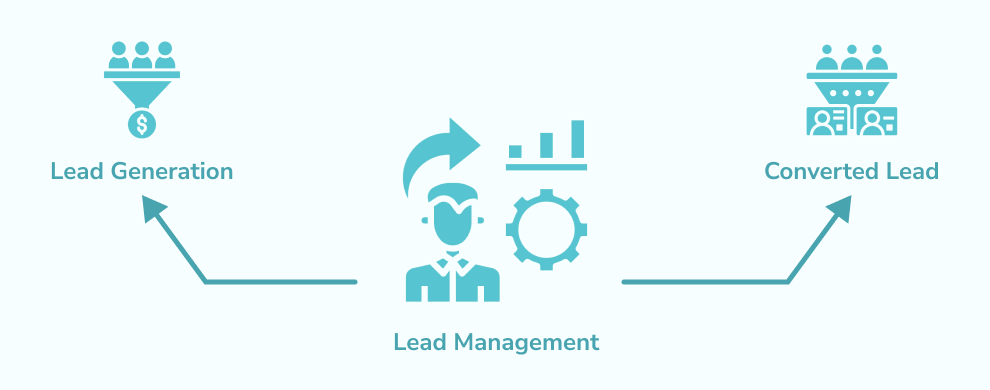How Leads Are Qualified
In the realm of B2B sales and marketing, success is not just a matter of “getting more sales leads,” it’s about doing a better job of lead management. Improving your company’s B2B lead management process can help you boost your conversion rates and create a more efficient sales cycle.
Let’s take a closer look at what lead management really means, why it matters to your company, and how it can help you tackle some specific business challenges.
What is Lead Management?
B2B sales is a long-term process. Along the way, your company will need to identify prospects, build relationships with those prospects, lead prospects through the buyer’s journey, address questions and objections, get buy-in from decision-makers and stakeholders, and more – before you ever close a deal.
Lead management helps to speed up the sales process. It’s a focused, strategic business discipline that enhances your company’s capabilities to build relationships with prospects. If lead generation is step 1 of the sales process, lead management is the next step – the follow-up, the organizing of leads, the thoughtful approach of sorting and ranking and better understanding your prospects.
Marketing and lead generation are often fast-paced and focused on customer acquisition: “let’s go out and get as many leads as we can!” Lead management is about slowing down a little bit, to take stock of what you really have in those new leads – and analyze which ones are highly-qualified business opportunities, and which ones need more time and effort before they’re ready to close a deal.
But too often, B2B lead management is misunderstood and overlooked. At too many B2B companies, good sales opportunities fall through the cracks, because there is no organized process in place to get the most value out of those leads. If you don’t commit to a focused strategy for B2B lead management, your company is going to face a few big risks:
- Causing miscommunications with prospects: What happens if you’re talking with a new prospect, and they get contacted multiple times by different salespeople? What if you have a prospect who’s eager to buy, but they get a basic introductory email with a brochure that they’ve already downloaded? What if you have a prospect who’s just in the early stages of researching your company, and they have a lot of questions – and instead, they get bombarded with a high-pressure sales call from a salesperson who (wrongly) assumed that the deal was almost ready to close? Better lead management can help avoid these glitches and misunderstandings that cause frustration for prospects.
- Missing out on qualified leads: In the B2B marketing world, it’s amazing how often qualified sales leads fall through the cracks. Your prospect might never get a follow-up call, never get into the sales process, and your company misses out on earning that revenue. Better lead management can help you keep track of all your leads, with consistent processes, so that you can maximize the value of your lead generation efforts.
- Losing customers to the competition: The way your company handles your sales leads sends a message to prospects about how they will be treated if they become your customers. Are your prospects feeling appreciated, and benefiting from a well-organized sales process with clear communication? Or are they feeling ignored, overlooked, or overwhelmed with too much irrelevant information and high-pressure offers that they’re not ready to hear? Even if you have a great solution and a great price, the B2B sales process matters. Customers might decide to go with a competitor if they’re receiving better treatment from that other company’s sales and marketing teams. Better lead management can improve your customer experience and enhance your brand reputation, even before your prospects become customers.
Let’s look at a few real-world challenges that a better B2B lead management process can help solve.

Lead Management for Qualifying Inbound Leads – Who Answers the Phone?
Companies invest significant amounts of money, time, and resources on generating sales leads. So when leads actually show up, it’s amazing to see how many companies aren’t ready to answer the phone or reply to an inbound email. One of the most important aspects of lead management is how well you can handle new leads that show up at your door, that express interest in your company, that click on your ad, and that want to talk with you.
When new inbound leads arrive, is your company prepared? Here are a few fundamentals for qualifying inbound sales leads:
- Get a dedicated phone number or email inbox for new inbound leads. Make sure your website contact form or any outbound marketing (PPC campaigns, social media, etc.) are directing people to the right place. New prospects might click on a social media ad and get directed to a rarely-checked messaging inbox. Check your social media accounts frequently, to make sure you don’t have new leads languishing there.
- Respond to new leads promptly – with a well-trained person who knows how to sell. Too often, when a new sales lead inquires at a B2B company, they go to a general voicemail, or the call gets picked up by an administrative assistant who might not be trained in sales. This is a missed opportunity! The first point of contact with a new prospect should be trained in sales, and be able to start the process of getting to know the prospect and building a relationship.
- Create an organized intake process for new leads. In the same way that sales reps have a calling script that they use for the first conversation on outbound sales calls, your team needs to be ready to have that first conversation with inbound leads. Start asking questions right away to gather information about the prospect’s situation, such as:
- What business challenges are they trying to solve?
- How long have they been researching your company?
- Are they looking at any competitors?
- Do they have an existing vendor?
- How soon would they like to have a follow-up conversation or demo with the sales team?
The goal of these questions is not to put pressure on the prospect, but just start to get to know them, understand their needs, and lay the groundwork for a larger sales-oriented conversation.
Ranking and Prioritizing New Sales Leads
Once you have that first conversation with a new sales prospect, whether it’s a result of inbound leads contacting your company, or outbound lead generation that drums up new sales appointments, it’s important to start ranking the leads. This is a simple way to prioritize sales leads, based on the expected urgency of the prospect’s willingness to buy.
Ranking sales leads is not an exact science. You need to take notes during your initial conversations with new prospects to evaluate:
- How much “pain” does this prospect seem to be in? How big are their business challenges, how urgently are they looking to make a change?
- Did the prospect mention any details about budget or timelines for decisions?
- Does the prospect already have an existing vendor relationship that they’re unhappy with and complaining about?
- Is the prospect saying things like “my CEO wants me to make this a priority” or “we’re hoping to move forward with some options by Q2 of next year?”
Next, you should create an orderly system for ranking leads. It could be as simple as “A, B and C” leads, with “A” leads being the highest-priority opportunities that seem to be most likely to buy, and the “C” leads being less-committed or less ready to buy. Having a lead ranking system doesn’t mean you ignore the “C” leads and put all your eggs into one basket with the “A” leads! It just means you have an organized way of focusing your sales team’s efforts and being prepared to handle different conversations in different ways, depending on the prospect.
For example, if you have a high-priority lead (“A” rated) that has already expressed interest in seeing a product demo, that has mentioned that they already have a budget dedicated to this purchase, and has said how frustrated they are with their current vendor or service provider? That sales conversation is going to sound different than a conversation with a “C” lead.
The A-rated, high-priority leads might:
- Be ready for a more detailed product demo – not just a basic introduction
- Be willing to meet with higher-level executives from your company
- Be open to hearing about ROI – not just pricing, but “how can your solution save me money or help me drive revenue?”
- Be receptive to a more advanced sales script for the early-stage conversations – don’t bog them down with too much detail if they’re already eager to hear more
This doesn’t mean that every A-rated lead is a slam dunk! You still need to work through the sales cycle. But by getting an early read on how eager or likely to buy each new sales prospect appears to be, your sales team can be better prepared to take the conversation in the right direction.
Long-term Lead Management: Nurturing Leads for Follow-up
For major account B2B sales, the sales cycle can be long and uncertain, with lots of ups and downs. Depending on your industry and solution, especially if you sell to big companies that have complex procurement processes, your sales cycle might be 1-2 years (or more). This requires careful handling of your B2B sales leads.
Along with ranking and sorting your sales leads by order of priority, your company needs to have a well-thought-out process for long-term lead nurturing. Some prospects are not going to be ready to buy anytime soon. They might need to do more research, they might have elaborate questions, or they might have internal budget constraints or other issues that are holding them back from making decisions.
For long-term leads, it’s important to keep track of them and follow up on an ongoing basis, but in a low-pressure, informative way. Here are a few fundamentals of lead nurturing to build into your process:
- Keep good records of your long-term leads. Whether it’s a Customer Relationship Management (CRM) system or a simple spreadsheet, keep notes about the last conversation you had with the prospect, any changes or timelines they mentioned, and any questions they asked.
- Broaden the relationship within the buyer’s organization. Long-term leads often need more time to build a business case within their company for why they should buy from you. Talk with the prospect about what other stakeholders within their company might want to have a meeting. For example, if you sell software, a big company might have multiple departments that would have to change their processes or contribute budget toward the purchase. Long-term lead nurturing can help identify all these stakeholders and bring them to the table.
- Treat different prospects differently. Don’t use a one-size-fits-all approach to lead nurturing. Long-term lead nurturing is more of an art than a science; different prospects will have different concerns and different reasons for why they’re not ready to buy. Some prospects might be waiting for a new year’s budget to be approved, while other prospects’ companies might be going through a restructuring that has delayed their procurement process. Some prospects might have specific questions about how your solution can be implemented to fit their existing systems, while other prospects might need help to get buy-in from multiple internal stakeholders who have a say in the final buying decision. Lead nurturing gives you an opportunity to customize your approach to each prospect and keep track of which specific issues or pain points they’re experiencing.
- Check in regularly. Establish a regular cadence of follow-up emails to your long-term leads. Whether it’s once a month or once a quarter, try to stay in touch and on their minds, even if they’re not ready to buy immediately. Offer to book additional sales demos with new stakeholders or meet with other departments at their company that would be involved in working with your solution. Send new marketing content, new announcements from your company, or industry news items that are relevant to your prospect’s situation. Be a helpful resource that can answer their questions and point out top trends and industry pain points where your solution can help them save time or money.
- Follow your prospect’s company news. Along with keeping your prospect updated about your company’s latest news, it’s important to stay in touch with your prospect’s latest news. Has your prospect’s company announced a new executive in the C-suite? Have they launched a new product or entered a new market? Have they made any acquisitions of other companies? Have they announced new hires or other signs of growth? Any of these news items can be an occasion to reach out for additional lead nurturing or to start a sales conversation.
B2B lead management doesn’t have to be complicated, but it does have to be organized. Make a plan for how to handle conversations and deliver a great experience to your prospects at every step of the sales process, whether or not they’re urgently ready to buy. Lead management is often a matter of being careful (and clear) with communication, understanding prospects’ needs, and identifying the unique “pain points” and challenges that are keeping your prospect from being ready to make a purchase decision. With better lead management, you can grow your sales pipeline, gain better consistency and predictability in your sales process, improve your sales conversion rates, and achieve bigger revenues.
Want to Know How Much B2B Lead Management Services Cost?
Contact us for a free consultation. We will develop a customized quote based on your business needs.


